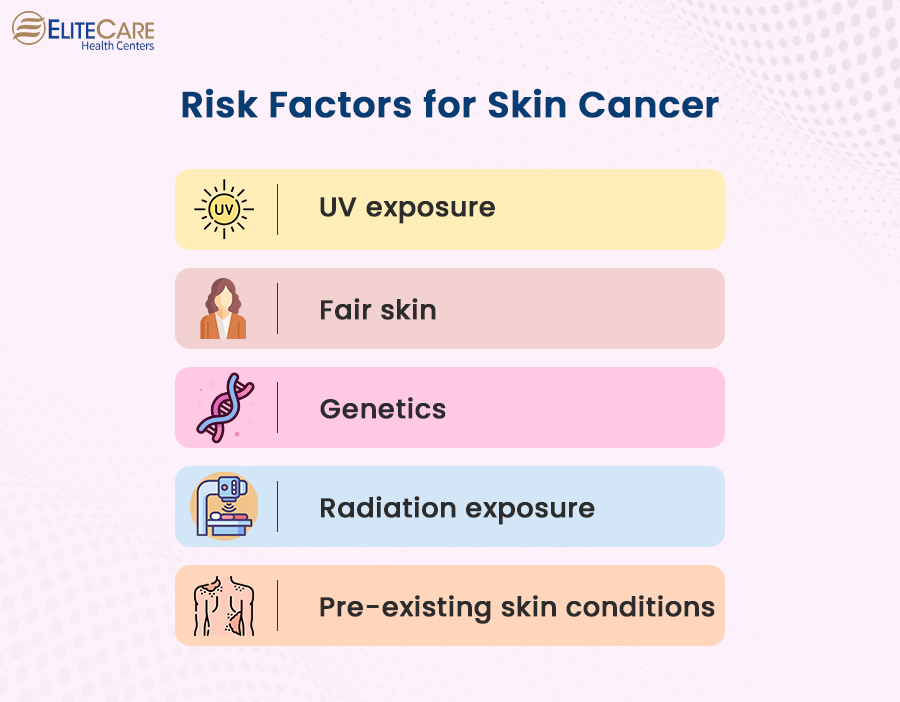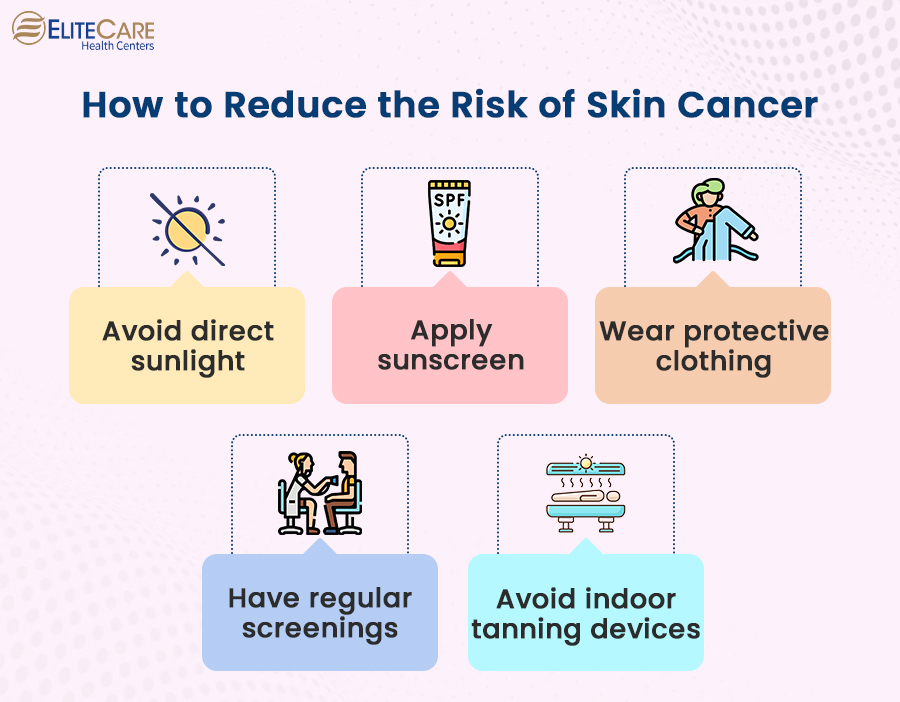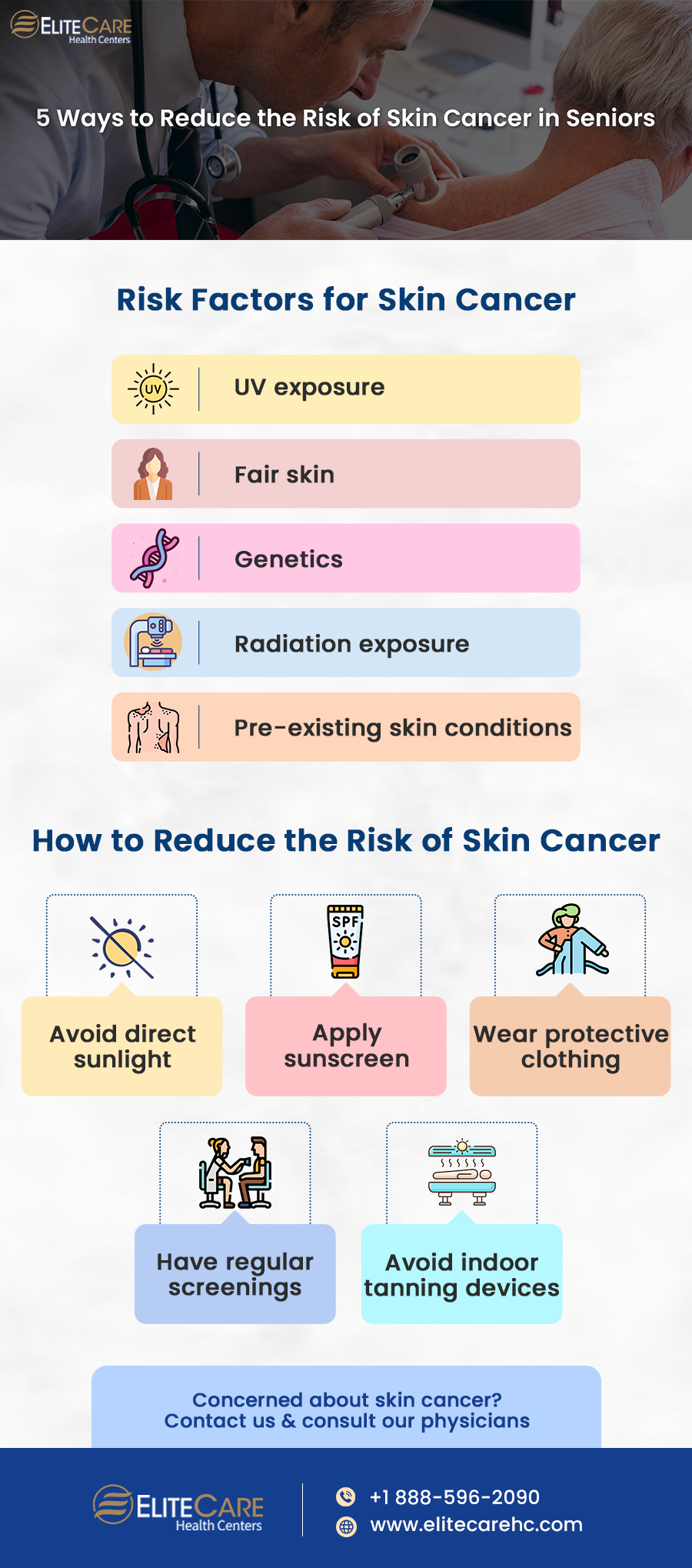
Skin cancer is a type of cancer that occurs when skin cells grow abnormally and uncontrollably, primarily due to ultraviolet (UV) exposure. There are three main types of skin cancer experienced by older adults: basal cell carcinoma, squamous cell carcinoma, and melanoma. While basal cell carcinoma and squamous cell carcinoma are common but less dangerous, melanoma is less common but more dangerous in nature.
According to the American Cancer Society, skin cancer is the most common type of cancer in the United States, and it is more common in older adults over the age of 50. Besides, seniors often suffer from multiple chronic conditions that make it more difficult for them to undergo skin cancer treatment. Therefore, it is critical for older adults to be aware of the risk of skin cancer and to take steps to prevent it.
In this blog post, we will share risk factors and early skin cancer symptoms in detail. Read on to learn more.
Risk Factors for Skin Cancer

Exposure to UV light
One of the most significant risk factors for any type of skin cancer is exposure to ultraviolet (UV) light, which includes both UVA and UVB radiation. Skin cancer may develop over time due to long-term exposure to natural sunlight or artificial sources like tanning beds.
Fair skin
Individuals with certain features like those who have fair skin, light hair, and blue or green eyes are at a higher risk of developing skin cancer.
Genetics
Skin cancer can be hereditary, particularly in the case of melanoma. Some genetic syndromes, such as xeroderma pigmentosum, can also increase a person’s susceptibility to UV damage and skin cancer.
Exposure to radiation
Those who are currently undergoing radiation treatment or had been through it in the past may have a higher risk of developing skin cancer.
Pre-existing skin conditions
Those with a history of certain skin conditions, such as actinic keratosis or dysplastic nevus, may be at a higher risk.
Visit a healthcare center and consult a primary care physician to check if you are at risk of developing skin cancer.
Early Skin Cancer Symptoms
Here are some early signs of skin cancer that seniors should look out for:
Changes in moles
A change in the size, shape, or color of a mole or moles that are asymmetric, have irregular borders, or have different colors can indicate skin cancer.
New growths
If there are any new abnormal growths on the skin, it may be a sign of skin cancer.
Rough or scaly patches
The presence of rough or scaly patches on the skin, such as actinic keratosis is a common sign of skin cancer.
Itching, bleeding or crusting
Skin cancer can cause a mole or spot on the skin to itch, bleed, or crust over.
If seniors notice any of these signs, they should consult a dermatologist right away. Early detection and treatment can help prevent cancer from spreading and improve the chances of successful treatment.
5 Ways to Reduce the Risk of Skin Cancer

1. Avoid direct sunlight
Ultraviolet (UV) rays are the main cause of skin cancer, and that is why it is important to limit exposure to direct sunlight. Seniors should stay in the shade or indoors during peak sunlight hours, typically from 10 a.m. to 4 p.m.
2. Apply sunscreen
Seniors must apply sunscreen every day, even on cloudy days, to protect their skin from UV rays. According to the American Academy of Dermatology, every individual must use a broad-spectrum sunscreen with an SPF of 30 or higher to ensure maximum protection of the skin from UV rays. Apply sunscreen 15 minutes before heading outside and reapply every two hours, or more often if swimming or sweating.
3. Wear protective clothing
Older adults can use protective clothing, such as long-sleeved shirts and wide-brimmed hats when they are outside to minimize the effects of UV radiation on their skin.
4. Limit indoor tanning
5. Have regular screenings
Routine skin exams by a dermatologist or a primary care physician can help in the early detection of any abnormal growth on the skin, which can eventually lead to skin cancer if not treated on time. Seniors should examine their own skin regularly and report any changes to a doctor.
Conclusion






